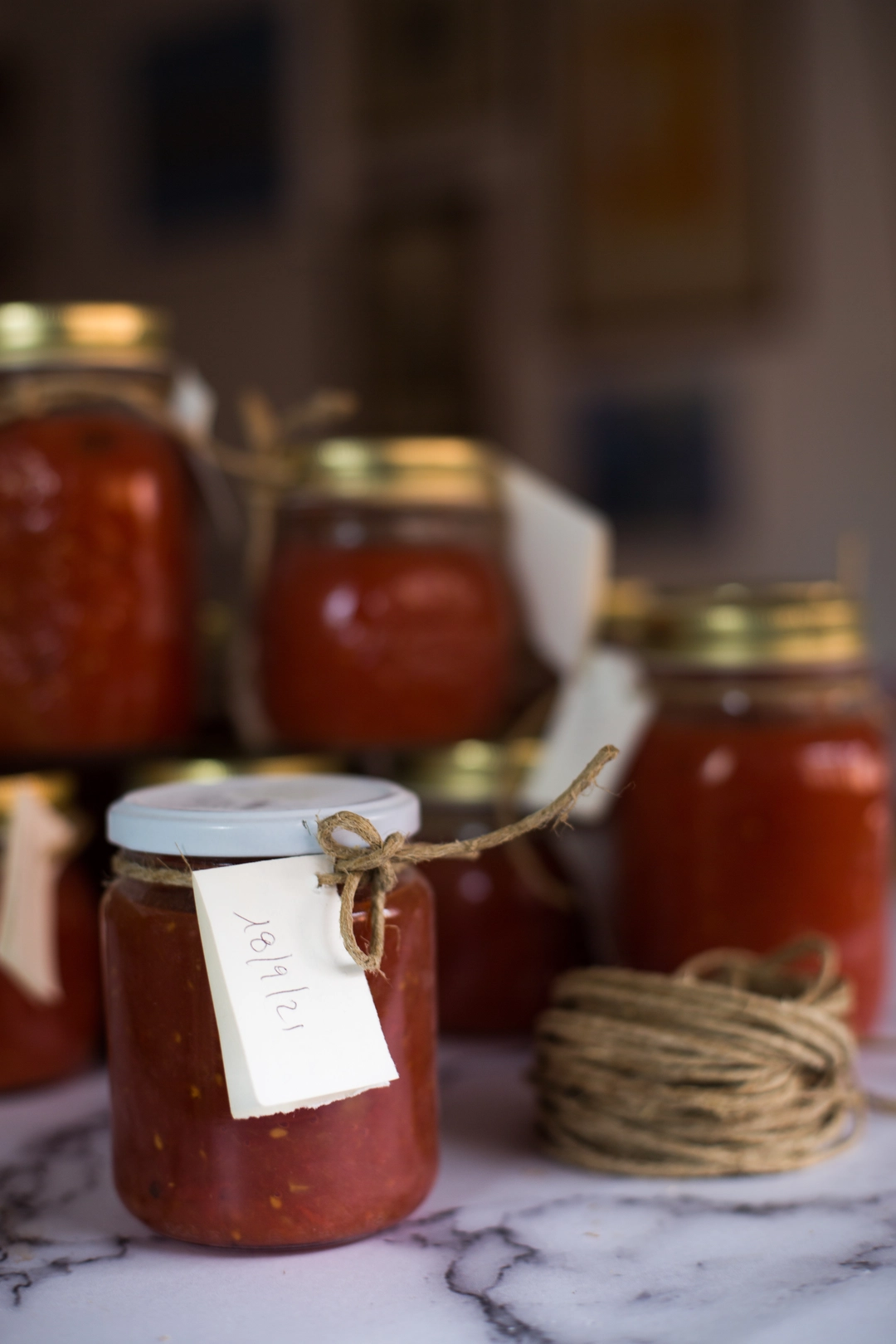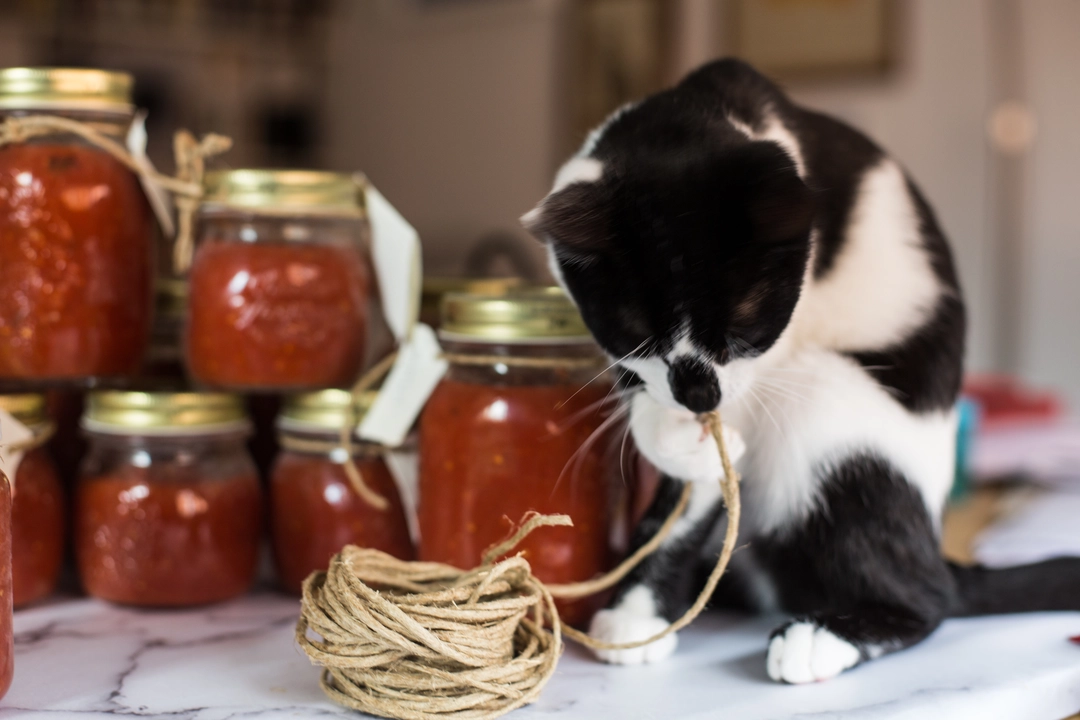I have read so many about tomato sauce that they deserve to become the pages of a novel. From the type of tomato that is used, to the secret mixes that create unexpected notes, from aromatic, to garlic, to salt, to "eh no! I use onion".
Behind a tomato sauce you can hide the most radical certainties and uncertainties of life.
I have found that someone mixes more types of tomato, from piccadilly, to ox heart, to balance textures and sweetness. In another case that I must say inspired me not a little I read about those who fry bay leaves and use this flavored oil as a last layer before closing the jars.
Mine is a lazy and slightly ignorant tomato sauce.
Definitely anarchic, because I improvised on everything, except on the rigorous wealth with which I sterilized vases and equipment.
I have a certain allergy for preparations that take too long, forgive me, I will be of the generation that wants everything immediately but the idea of facing the past has always worried me a little.
Years ago, in the summer, when I had the opportunity to stay in the countryside with my parents, I accompanied my mother in this Augustan torture that sometimes lasted several days, despite the fact that the thermometer touched the humid 35 ° C of the Venetian mainland.
Once I became an adult I remember making pots on pots to restore the stocks of the restaurant I worked for. The burning splashes that hover in the sky, the dozens of glass jars to be sterilized, red crates as far as the eye can see able to redefine the concept of space-time, the caps that in the end one is always missing. A rough road, in short, that of tomato sauce, dotted with unexpected events and sweat, often also with mosquitoes. Because sanmarzano is not a saint and all this has nothing idyllic about it.
And yet, despite this, she is the protagonist of the most tender tales. A bit like the birth of which - they say - you forget the pain, even the tomato sauce returns strongly to the hearts as soon as the first breeze at the end of September ruffles the hair and our thoughts turn to the cold and green months that await us...
Here, the tomato sauce that I want to tell you today is a sort of mediation that is anything but reverent towards tradition, indeed I would rather say that it has the ambition to inaugurate my personal tradition in a rather free and light-hearted way. I didn't go too far on the ingredients, all untreated: sanmarzano tomatoes, unrefined salt, Abruzzo garlic, dried laurel and a few tricks. Nothing more.
In the photo the tomato sauce with an exceptional model, the young Ada, known as Dadina.
Behind a tomato sauce you can hide the most radical certainties and uncertainties of life.
I have found that someone mixes more types of tomato, from piccadilly, to ox heart, to balance textures and sweetness. In another case that I must say inspired me not a little I read about those who fry bay leaves and use this flavored oil as a last layer before closing the jars.
Mine is a lazy and slightly ignorant tomato sauce.
Definitely anarchic, because I improvised on everything, except on the rigorous wealth with which I sterilized vases and equipment.
I have a certain allergy for preparations that take too long, forgive me, I will be of the generation that wants everything immediately but the idea of facing the past has always worried me a little.
Years ago, in the summer, when I had the opportunity to stay in the countryside with my parents, I accompanied my mother in this Augustan torture that sometimes lasted several days, despite the fact that the thermometer touched the humid 35 ° C of the Venetian mainland.
Once I became an adult I remember making pots on pots to restore the stocks of the restaurant I worked for. The burning splashes that hover in the sky, the dozens of glass jars to be sterilized, red crates as far as the eye can see able to redefine the concept of space-time, the caps that in the end one is always missing. A rough road, in short, that of tomato sauce, dotted with unexpected events and sweat, often also with mosquitoes. Because sanmarzano is not a saint and all this has nothing idyllic about it.
And yet, despite this, she is the protagonist of the most tender tales. A bit like the birth of which - they say - you forget the pain, even the tomato sauce returns strongly to the hearts as soon as the first breeze at the end of September ruffles the hair and our thoughts turn to the cold and green months that await us...
Here, the tomato sauce that I want to tell you today is a sort of mediation that is anything but reverent towards tradition, indeed I would rather say that it has the ambition to inaugurate my personal tradition in a rather free and light-hearted way. I didn't go too far on the ingredients, all untreated: sanmarzano tomatoes, unrefined salt, Abruzzo garlic, dried laurel and a few tricks. Nothing more.
In the photo the tomato sauce with an exceptional model, the young Ada, known as Dadina.
METHOD
I started by sterilizing the jars and caps. First I washed them with soap and water (a little), rinsing them thoroughly. Then I placed them on a dripping pan and baked in a cold oven. I brought them to 100 degrees, then I turned off the oven and let them cool without touching them. In the oven I also put a couple of metal ladles and the metal funnel that I will use to pour the sauce into the jars. From here on I used disposable gloves.
Why was I so careful? Because with preserves there is a risk of developing Botox. In general, therefore, it is necessary to be particularly precise in washing vegetables and sterilizing the equipment. In general, you can follow the instructions you find on the Ministry of Health website, which are the fundamental guidelines to follow when making this type of preparation.
I thoroughly washed the tomatoes with plenty of water, leaving them immersed for about twenty minutes, so that if by mistake there were any unwanted residues on the surface, they would go away. I threw the water and put ¼ of the tomatoes in the bucket. I filled the other half of the sink with cold water. I covered the tomatoes with boiling water and then I dipped them in cold water. That way it was quick and easy for me to peel them. I repeated the operation until I finished the tomatoes. I was not accurate in doing it, I rather worked quickly, leaving out pieces of peel. I limited myself to removing the bulk and removing the point where the petiole attaches. I then gradually cut them into 4 parts and put them in the pot. I made use of 3 large pots, filled to a little more than half. In this way, once it has boiled, the splashes will not come out of the pot, burning you and soiling the hob (or the wall!). I brought the tomatoes to a boil, adding the garlic, salt and bay leaf equally distributed in each pot. I cooked the tomato for 1 hour, first over high heat and then lowering the heat, stirring often. I removed the bay leaf and blended with the hand blender.
Yes, you got it right.
I did not pass the sauce, I reduced it to a raw sauce, thus breaking up the remaining skins. I put it back on the heat and let the (little) water I had in excess evaporate.
I then potted the puree, which was still very hot, with the help of the previously sterilized funnel. I closed the jars tightly and let them cool. Finally I placed them in large pots (I used 4) trying to fit them together so that they do not bang together excessively. I know that there are those who use tea towels between one vase and another, I must say that I didn't need it. I covered the jars with cold water, making sure that the water exceeded their height by 4 fingers, bringing to a slow boil. Once it reached the boil I counted half an hour, then I turned it off and let it cool.
I chose to proceed in this way because personally I don't mind the tomato seeds and because, being organic tomatoes, I found it absurd to go crazy to remove the skins, when they too have nutritional properties and organoleptic characteristics. I didn't add basil because I don't like using fresh herbs in cooking, I find that they lose much of their flavor and properties, I prefer instead to add a fresh leaf when I open the jar and be free to characterize with the aroma that I like best. based on the use I have to make of the past.
Ah one last trick. I made the pass in early September. Although sunny, the weather (in Italy, I mean) is definitely different than in August! But this cannot be an absolute precaution, because it always depends on how the season has developed.
Preparation time
about 6 hours

